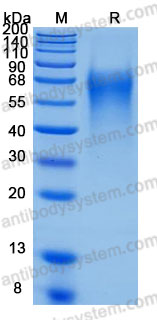Catalog No.
AHB60001
Biological activity
Measured by its binding ability in a functional ELISA. When rhLYPD3 (Cat #: AHB60001) is immobilized at 0.5 μg/mL (100 μL/well), rhGalectin-3 binds with an apparent KD <80 nM.
Expression system
Mammalian Cells
Species
Homo sapiens (Human)
Protein length
Leu31-His286
Nature
Recombinant
Endotoxin level
<0.1 EU/μg of the protein by the LAL method.
Purity
>90% as determined by SDS-PAGE.
Accession
O95274
Applications
Bioactivity, ELISA, Immunogen, SDS-PAGE, WB
Form
Lyophilized
Storage buffer
Lyophilized from a solution in PBS pH 7.4, 5% Trehalose, 5% Mannitol.
Reconstitution
Reconstitute in sterile water for a stock solution. A copy of datasheet will be provided with the products, please refer to it for details.
Shipping
In general, proteins are provided as lyophilized powder/frozen liquid. They are shipped out with dry ice/blue ice unless customers require otherwise.
Stability and Storage
Use a manual defrost freezer and avoid repeated freeze thaw cycles. Store at 2 to 8°C for one week. Store at -20 to -80°C for twelve months from the date of receipt.
Alternative Names
C4.4A, Matrigel-induced gene C4 protein, GPI-anchored metastasis-associated protein C4.4A homolog, MIG-C4, LYPD3, Ly6/PLAUR domain-containing protein 3
A method for the identification of lactate metabolism-related prognostic biomarkers and its validations in non-small cell lung cancer., PMID:39962075
A High-Affinity Monoclonal Antibody Against the Pancreatic Ductal Adenocarcinoma Target, Anterior Gradient-2 (AGR2/PDIA17)., PMID:39727484
m6A-dependent mature miR-151-5p accelerates the malignant process of HNSCC by targeting LYPD3., PMID:39009906
Transcriptome analysis of human dental pulp cells cultured on a novel cell-adhesive fragment by RNA sequencing., PMID:38901533
Comprehensive analysis of exosome gene LYPD3 and prognosis/immune cell infiltration in lung cancer., PMID:38617517
LY6/PLAUR domain containing 3 (LYPD3) maintains melanoma cell stemness and mediates an immunosuppressive microenvironment., PMID:37924160
Updated skin transcriptomic atlas depicted by reciprocal contribution of single-nucleus RNA sequencing and single-cell RNA sequencing., PMID:37407342
Establishment, characterization, and drug screening of low-passage patient individual non-small cell lung cancer in vitro models including the rare pleomorphic subentity., PMID:37228492
A Novel NAMPT Inhibitor-Based Antibody-Drug Conjugate Payload Class for Cancer Therapy., PMID:35658441
LYPD3, a New Biomarker and Therapeutic Target for Acute Myelogenous Leukemia., PMID:35360840
Arsenic Exposure and Cancer-Related Proteins in Urine of Indigenous Bolivian Women., PMID:33381488
AP-1 and TGFß cooperativity drives non-canonical Hedgehog signaling in resistant basal cell carcinoma., PMID:33033234
CircCBFB-mediated miR-28-5p facilitates abdominal aortic aneurysm via LYPD3 and GRIA4., PMID:32151690
Crystal Structures of Human C4.4A Reveal the Unique Association of Ly6/uPAR/α-neurotoxin Domain., PMID:32140067
β2-Adrenergic Signalling Promotes Cell Migration by Upregulating Expression of the Metastasis-Associated Molecule LYPD3., PMID:32098331
Elevated Expression of LYPD3 Is Associated with Lung Adenocarcinoma Carcinogenesis and Poor Prognosis., PMID:32040344
The Lineage Determining Factor GRHL2 Collaborates with FOXA1 to Establish a Targetable Pathway in Endocrine Therapy-Resistant Breast Cancer., PMID:31644911
Long non-coding RNA OGFRP1 regulates LYPD3 expression by sponging miR-124-3p and promotes non-small cell lung cancer progression., PMID:30274775
Network-based co-expression analysis for exploring the potential diagnostic biomarkers of metastatic melanoma., PMID:29377892
Cell-surface marker discovery for lung cancer., PMID:29371917
Expression of C4.4A in an In Vitro Human Tissue-Engineered Skin Model., PMID:29075641
De novo synthesis of C4.4A in hepatocellular carcinoma promotes migration and invasion of tumor cells., PMID:29048672
Expression and crystallographic studies of the D1D2 domains of C4.4A, a homologous protein to the urokinase receptor., PMID:28777093
Preclinical Antitumor Efficacy of BAY 1129980-a Novel Auristatin-Based Anti-C4.4A (LYPD3) Antibody-Drug Conjugate for the Treatment of Non-Small Cell Lung Cancer., PMID:28292941
LY6/PLAUR domain containing 3 has a role in the maintenance of colorectal cancer stem-like cells., PMID:28238780
C4.4A gene ablation is compatible with normal epidermal development and causes modest overt phenotypes., PMID:27169360
New Blocking Antibodies against Novel AGR2-C4.4A Pathway Reduce Growth and Metastasis of Pancreatic Tumors and Increase Survival in Mice., PMID:25646014
Expression of the Ly6/uPAR-domain proteins C4.4A and Haldisin in non-invasive and invasive skin lesions., PMID:25414274
C4.4A as a biomarker in pulmonary adenocarcinoma and squamous cell carcinoma., PMID:25302166
Expression of C4.4A is a potential independent prognostic factor for patients with gastric cancer., PMID:24935570
C4.4A highly expressed in HER2-positive human breast cancers may indicate a good prognosis., PMID:23918676
The metastasis-associated molecule C4.4A promotes tissue invasion and anchorage independence by associating with the alpha6beta4 integrin., PMID:23727360
Concurrent expression of C4.4A and Tenascin-C in tumor cells relates to poor prognosis of esophageal squamous cell carcinoma., PMID:23708783
C4.4A expression is associated with a poor prognosis of esophageal squamous cell carcinoma., PMID:23435632
Ly6/uPAR-related protein C4.4A as a marker of solid growth pattern and poor prognosis in lung adenocarcinoma., PMID:23287851
Distinct expression of C4.4A in colorectal cancer detected by different antibodies., PMID:23175173
Membrane-bound and exosomal metastasis-associated C4.4A promotes migration by associating with the α(6)β(4) integrin and MT1-MMP., PMID:22431918
C4.4A is associated with tumor budding and epithelial-mesenchymal transition of colorectal cancer., PMID:22404718
Expression of C4.4A in precursor lesions of pulmonary adenocarcinoma and squamous cell carcinoma., PMID:21792890
Altered LKB1/CREB-regulated transcription co-activator (CRTC) signaling axis promotes esophageal cancer cell migration and invasion., PMID:21706049
Expression of C4.4A, a structural uPAR homolog, reflects squamous epithelial differentiation in the adult mouse and during embryogenesis., PMID:21339181
Expression of C4.4A at the invasive front is a novel prognostic marker for disease recurrence of colorectal cancer., PMID:20825414
Raising gestational choline intake alters gene expression in DMBA-evoked mammary tumors and prolongs survival., PMID:19047067
Metastasis-associated C4.4A, a GPI-anchored protein cleaved by ADAM10 and ADAM17., PMID:18979631
Estrogen, not intrinsic aging, is the major regulator of delayed human wound healing in the elderly., PMID:18477406
C4.4A as a candidate marker in the diagnosis of colorectal cancer., PMID:17912244
Altered expression of the urokinase receptor homologue, C4.4A, in invasive areas of human esophageal squamous cell carcinoma., PMID:17849475
Tumour cell expression of C4.4A, a structural homologue of the urokinase receptor, correlates with poor prognosis in non-small cell lung cancer., PMID:17706320
[Expression and diagnostic application of C4.4A protein in squamous cell carcinoma and adenocarcinoma]., PMID:16776998
Ly6 family member C4.4A binds laminins 1 and 5, associates with galectin-3 and supports cell migration., PMID:15729693


